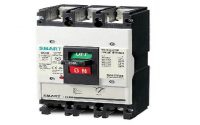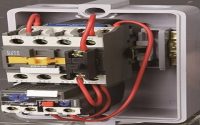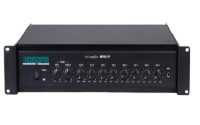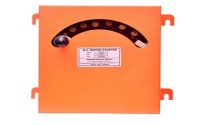What is HRC Fuse : Working & Its Applications
The flow of current in an electrical network is within a fixed limit. Once the flow of current in the network crosses the fixed limit, a fault occurs within the network like phase to ground or phase to phase short circuit. When the flow of current may have a high thermal effect then pieces of equipment that are connected to the network will be damaged permanently. To overcome this damage from faults, an electrical fuse is used. A fuse is an electrical device that includes a conductor. This conductor easily melts & splits the circuit connection once the flow of current exceeds the fixed value. So this is the weakest part of an electrical circuit. There are different types of fuses available in the market. So this article discusses an overview of what is HRC fuse, working principle, construction, and its applications.
What is HRC Fuse?
Definition: HRC fuse (high rupturing capacity fuse) is one kind of fuse, where the fuse wire carries a short circuit current in a set period. If the fault occurs in the circuit then it blows off. The HRC fuse is made with glass otherwise some other kind of chemical compound.
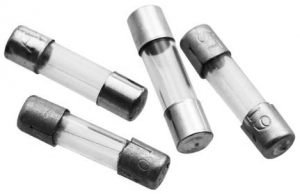
The enclosure of the fuse can be closed tightly to avoid the air from the atmosphere. At both sides of the fuse, the ceramic enclosure is made with a metal cap which is welded with fusible silver wire. Its enclosure includes some space that is surrounding by wire otherwise element of the fuse.
HRC fuse is consistent & it has the feature like if it has a high fault current then break time is low. Similarly, if the fault current is not high, then break time is long.
Working Principle of HRC Fuse
In normal conditions, the flow of current through the fuse doesn’t provide sufficient energy to soften the element. If the huge current flows through the fuse then it melts the element of the fuse before the fault current achieves the climax.
When the fuse is in an overload condition, then the element of the fuse will not blow-off however if this condition exists for an extended period, then the material like Eutectic will dissolve & break the element of the fuse. When the fuse is in short circuit condition, then the thin parts of the fuse element is less area will dissolve quickly & will smash before the eutectic material. So this is the reason to provide the limitations within the element of HRC Fuse.
Construction of HRC fuse
The construction of HRC fuse includes a material that has high heat resistant body like ceramic. This ceramic body includes metal-end caps that are welded through an element that carries silver-current.
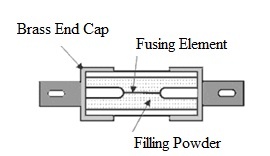
The internal space of the fuse body is filled by a filling powder material. Here the material used in this is quartz, plaster of Paris, dust, marble, chalk, etc. So this is the reason the flow of current cannot overheat. The generated heat vaporizes the melted element. The chemical reaction will occur between filling power and silver vapor to result in high resistance material to help in reducing the arc within the fuse.
Generally, copper or silver is used as the fuse element because of its low specific resistance. This element has normally two or more sections. The fuse element normally has two or more sections that are connected through tin joints. The melting point of tin is 2400 C that is lesser than silver’s melting point of 980o C. Thus the melting point of tin joints stops the fuse from getting high temperatures in the short circuit and overload conditions.
Types of HRC Fuse
These fuses are available in three types which include the following
- NH Type Fuse
- Din Type Fuse
- Blade Type
NH Type Fuse
This kind of fuse gives the protection of short circuit and overload for low & medium voltage. These fuses give protection for starters of the motor as well as other devices which are against overload and short circuit. These fuses are available in less weight with a solid dimension.
Din Type Fuse
These are accessible in a broad range of rated currents and are used in different fields for different reasons including their feature at different temperature states. These are accessible to different levels of voltages and used to protect the transformer. The cleaning capacity of this is excellent for perfect with the short-circuit act. These are used in air & mining, feeder sectionalizing, gas-insulated switchgear, and transformers.
Blade Type Fuse
This type of fuse is also called plug-I or spade. These are available with plastic body & two metal caps to arrange within the socket. Generally, these are used in cars to give protection from short circuits, wiring, and used in motors for backup protection. These are available in less weight and include less cutoff current. Blade type fuses are available in various sizes & shapes along with the capacity of different current ratings
Characteristics of HRC Fuse
A fuse works once its element dissolves because of the heat generated through I2RF. Here, RF is the resistance of the fuse. If the flow of current through the fuse increases, then the generated heat also increases. So, a fuse element can soften quicker for huge fault current whereas it will take a little bit for the lesser value of fault current. Thus, the relationship between the time-current of the fuse is named as fuse characteristics. For proper selection of fuse, it is very useful for a particular circuit.
Advantages
The advantages of these fuses include the following.
- These are cheaper as compared with other types
- Easy to design and very simple
- Maintenance is not necessary
- High breaking capability
- The performance of this is consistent.
- Easy operation
- The inverse time characteristic is suitable for overload protection
Disadvantages
The disadvantages of these fuses include the following.
- These cannot be reused once they blew out.
- It causes overheating for nearby contacts.
- The possibility of interlocking is larger
- After every action, they have to be changed.
- Heat is generated through the arc may influence the connected switches
Applications of HRC Fuse
The applications of these fuses include the following.
- HRC fuses are used to protect the circuit from short circuits in HV switchgear.
- Used for backup safety
- Used to protect electrical devices like motors, transformers, automobiles, etc
- These types of fuses are used in stators of motor
Thus, this is all about an overview of HRC fuse. From the above information finally, we can conclude that the capacity of the current-carrying of a fuse wire mainly depends on different factors such as the material, dimensions, length, diameter, shape, size, etc. Here is a question for you, How to interpret the fuse characteristics?

